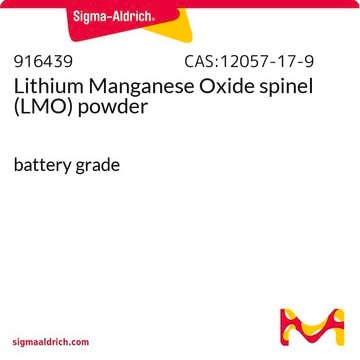934771
Lithium iron phosphate
electrode sheet, aluminum substrate, size 5 in. × 10 in.
Synonym(s):
LFP electrode
About This Item
Recommended Products
material
aluminum substrate (current collector)
Quality Level
grade
battery grade
description
Capacity: >= 170 mAh/g
Description/Nominal Voltage: 3.2 V vs. Li/Li+
Assay
≥98% (active material characteristic)
composition
Active material loading 7.3 mg/cm2 ± 5%, ≥85%
greener alternative product characteristics
Design for Energy Efficiency
Learn more about the Principles of Green Chemistry.
sustainability
Greener Alternative Product
size
16 μm , aluminum current collector
5 in. × 10 in.
thickness
70 μm ± 5% , excluding current collector
pore size
~2 μm particle size (active material characteristic)
capacity
≥170 mAh/g (Nominal)
application(s)
battery manufacturing
greener alternative category
Related Categories
General description
Application
related product
Storage Class Code
13 - Non Combustible Solids
WGK
WGK 3
Flash Point(F)
Not applicable
Flash Point(C)
Not applicable
Certificates of Analysis (COA)
Search for Certificates of Analysis (COA) by entering the products Lot/Batch Number. Lot and Batch Numbers can be found on a product’s label following the words ‘Lot’ or ‘Batch’.
Already Own This Product?
Find documentation for the products that you have recently purchased in the Document Library.
Our team of scientists has experience in all areas of research including Life Science, Material Science, Chemical Synthesis, Chromatography, Analytical and many others.
Contact Technical Service








